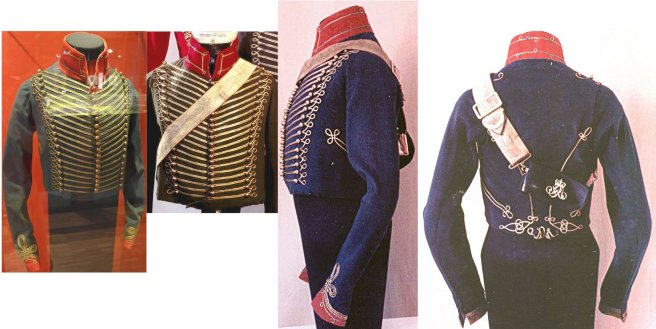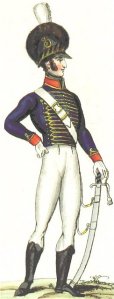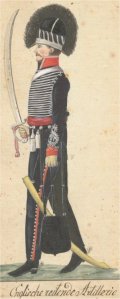The discussion that follows assumes a basic knowledge of the dress of the British artillery for this period, rather than starting from scratch. Sources mentioned below are mostly documented on page 1. For the Legion’s foot artillery see page 11 and for the KGL Gunner Drivers see page 13. Click to enlarge images.
As the clothing of British artillery, that of the KGL included, was the responsibility of the Board of Ordnance, this might appear a straightforward topic, but questions remain. Beamish’s history of the Legion confirms that “The [KGL] artillery were put under the board of ordnance from the 1st August, 1806” (Vol 1 page 85), and that “The uniform of the artillery … was in every respect similar to that of the same corps in the British service” (page 81). (The Hamilton Smith chart confirms this for the foot artillery, but includes no specific entry for the KGL horse batteries, while Smith’s entry for the RHA is not accurate.)
Other ranks
The Beamish plate of a horse battery gunner shows what appears to be RHA uniform, though the red cuffs are shown, rather oddly, as round but with a pointed loop above – a detail later copied literally by Knötel. The Tarleton has a crowned circular badge, conceivably a royal cypher within a strap, and the turban is shown as black, both in line with RHA uniform of the time. Full dress white breeches or pantaloons are worn with Hessian boots.
Later illustrators, reasonably enough, base their other ranks on known RHA uniform.
Officers
Primary sources
None of the period evidence is necessarily at odds with the RHA model, but given that it reveals something of what KGL HA officers actually wore, it’s worth examination.
The von Röder painting
This eyewitness image of 1813 includes some obvious inaccuracies, but is still important and useful. The braid and metal has a white appearance, but should be understood as gold. The Tarleton helmet is badly rendered, with no plume and a strange bandage-like strip along the base, but the black turban conforms to RHA uniform. The cuff decoration suggests an Austrian knot ornamented with eyes, as worn on some RHA officer’s jackets.
The crimson sash has gold knots (see also under “Meyer”, below), and the sabre belt and sabretache are black. The dark blue of the overalls is compatible with evidence in the Meyer ledger (see below); they show no cuffing or strapping, but have metal buttons down the outside seam or fly, with a scarlet stripe.
The Celle jacket
An officer’s jacket survives at the Bomann Museum at Celle. This presents no major surprises, though one or two minor aspects are not quite reconcilable with the details of jackets in the Meyer ledger, below. The front has 20 loops, with large gilt ball buttons at the closing edge and small ball buttons on the outer rows. (On the Meyer jackets, the minimum appears to be 21 loops.) From photos, it’s not possible to distinguish any difference between different areas of braiding, and it may be that the whole jacket is ornamented in gold royal cord, with no French braid or figuring braid as on the Meyer jackets.

The collar is traced round with gold cord, set in well from the edges, with an eye at each front corner and with three eyes above and below at the back of the neck – the central eyes facing inwards, the outer pairs facing the edges. The pointed cuffs support a crow’s foot or trefoil of three cords or braids (as opposed to the Austrian knot of the von Röder figure), with a line below inset onto the cuff and forming three eyes, one upwards at the point, one downwards at each side. The pockets are edged in cord with a crow’s foot at each end. The side seams are traced in a single line of cord, forming a crow’s foot at each top end, with two eyes and an Austrian knot at the lower ends. Altogether, the light cavalry styling is typical enough.
The jacket is sometimes displayed with an associated belt and pouch; the belt is formed of gold lace and the pouch is black with a gilt crowned cypher.
The Meyer ledger
Nine officers of KGL horse batteries have surviving accounts in the Meyer ledger between 1809 and 1814, but mainly from 1809 to 1811. (Thanks to Meyer & Mortimer and to Ben Townsend for images.)
Jackets
Six officers have entries in the ledger from 1809 to 1811 for nine jackets or batches of materials for jackets. In several cases these are noted as being “to the pattern of the Royal Horse Artillery”. As already noted, one or two finer details do not quite match the Celle jacket.
Meyer’s jackets are of superfine [dark] blue cloth with scarlet collar and cuffs, black silk serge body lining and Morocco leather, presumably red, on the bottom edge. Some are recorded as having 21, 22 or 24 loops on the front, 21 possibly being the default number unless extra are specified. The loops hold large ball buttons at the front edge and small ball buttons at each end. The front looping requires from 19 to 19⅜ yards of gold royal braid, the remaining ornamentation using 15 yards of gold breast braid and 17 yards of gold figuring braid.
Pelisses
Two pelisses are recorded in the ledger, in 1811 and 1814. Both are of superfine [dark] blue cloth, lined with scarlet plush, with scarlet silk or silk serge sleeve linings and grey “Cremer” fur trim, i.e. Crimean fox. Each has 24 loops with five rows of gilt ball buttons – large buttons at the closing edge and 96 small ball buttons for the four outer rows. However, the cord and braid lacing is in mohair or silk, almost certainly dark blue, in the manner of a cavalry undress pelisse. Details of ornamentation must have varied, as the 1811 pelisse uses 30 yards of royal cord, presumably mainly for the looping, with eight yards of French braid and 18 of figuring braid for seams, cuffs and so on, all in mohair, while the 1814 example, apparently more complex, uses 22 yards of royal cord, nine of French braid and 38 of figuring, all in silk. The relatively low price for the necklines indicates that these also were in dark blue, not gold.
Philip Haythornthwaite’s Osprey Wellington’s Specialist Troops (1988) documents the use on such pelisses for the Royal Horse Artillery of fabric olives (toggles) rather than gilt buttons; it may be that the KGL followed its own custom in this respect, though it’s not really possible to generalise from just two examples.
Waistcoats
The ledger notes four waistcoats for two officers between 1809 and 1814, one of white Marcella (a textured fabric sometimes called “quilted”) and three of cassimere, including one in white with three rows of regimental buttons – a nod to cavalry styling.
Pantaloons
Entries for seven officers include 22 pairs of pantaloons purchased between 1809 and 1811 and one in 1814. Of these, 16 are in [dark] blue, mostly in six or eight thread milled stocking. The majority are ornamented in royal cord, in one case noted as of mohair and in another as with additional figuring braid; in a few cases the trim is recorded as in braid, including mohair or silk French braid, the latter with additional figuring braid. All this ornamentation – Austrian knots and outer seam stripe – would be in dark blue.
Six pairs are of white cotton stocking, the majority described as ornamented with cord, in two cases as with cotton royal cord plus 12 yards of cotton figuring braid. This would be in white.
Overalls
Four pairs for two officers are recorded in 1809 and 1814. The pair from 1809 are of superfine [dark] blue cloth, with black leather strapping and chains. Two pairs from 1814 for the same officer include one in superfine [dark] blue cloth, strapped with the same and with no lace (presumably for undress), and one in mixed (grey) milled cassimere, strapped with the same and the sides laced in “rich gold lace”, presumably for dress. A third pair, noted simply as “Wellington overalls”, were presumably in grey. (The use of dark blue and grey matches that of the foot artillery, as noted on page 11.)
Greatcoats
Five officers purchased these between 1809 and 1814, all of superfine [dark] blue cloth. Where details are given, one coat is noted as double breasted, and two as having plain gilt buttons. Sleeve linings are noted as either black silk serge or linen. All these coats appear to be “made plain”. As noted on page 11 for the foot artillery, there is no sign of the single breasted or grey coats given as “regulation” for artillery in some sources.
Sashes
An 1814 entry includes “a Huss[ar] sash with Gold knots”; at a full 15 guineas this may have been a barrelled sash rather than the crimson type shown in the von Röder image above.
Later versions
KGL horse artillery officers have not been a frequent subject for later illustrators. It’s worth noting (though a bit obvious) that the officer plate in von Pivka’s Osprey title of 1974 is untrustworthy in many details.
page 9: ‘Heavy’ Dragoons 1803-13
page 10: Light Dragoons 1813-16
page 15: Depot Company, Independent Garrison Company, Veteran Battalion


